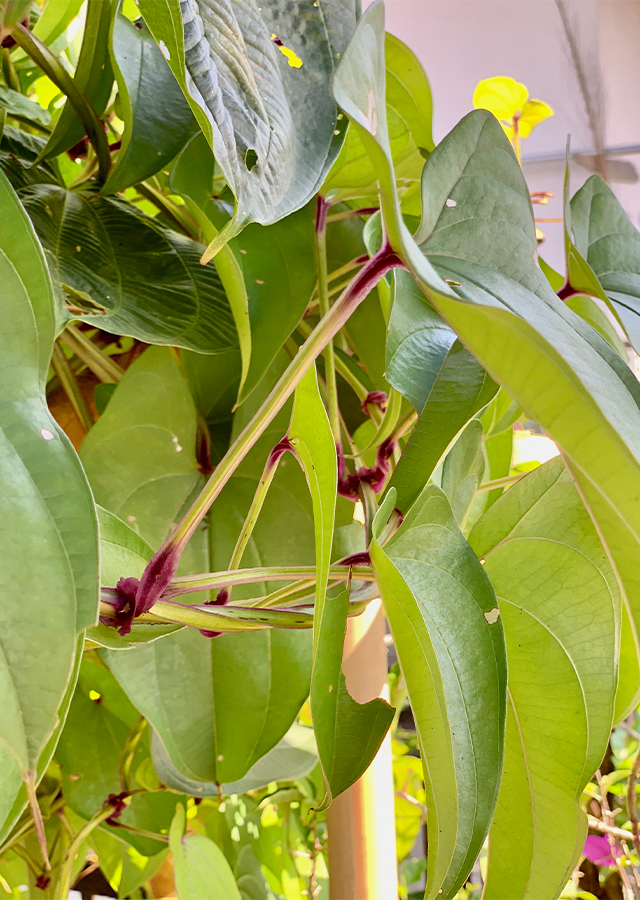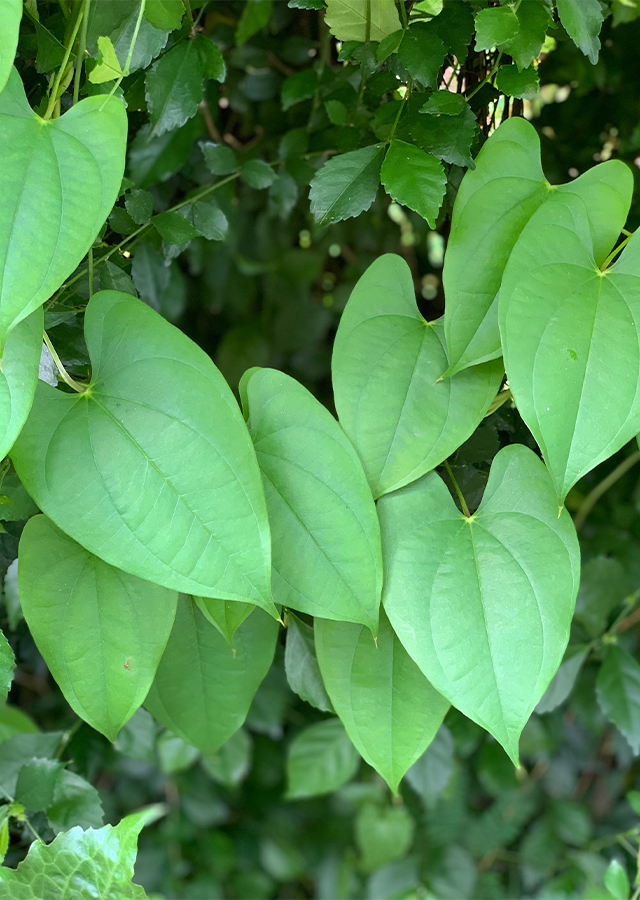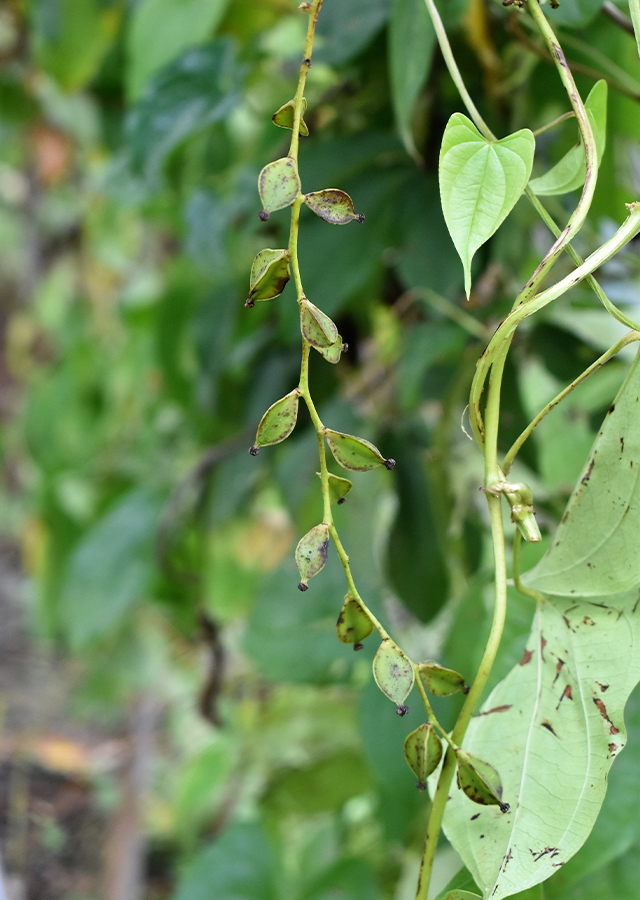Greater Yam, Water yam, Winged Yam
Dioscorea alata L.
Dioscoreaceae
Location in our garden
Principal



Synonym
Dioscorea atropurpurea Roxb.
Dioscorea colocasiifolia Pax
Dioscorea eburina Lour.
Habitus
Climbers. A vigorous, perennial, climbing plant, producing annual stems up to 15 m long from a very large tuberous rootstock .
Part Used
Tuber
Growing Requirements
Full Sunshine
Need Shade
Drought Resistant
Habitat
Forest
Roadside
Terrestrial
Overview
Water yam originated from South-East Asia and has been spread worldwide in the tropics. Water yam is the most important tuber crop in the world, it is considered as the third most after cassava and sweet potato. It is also a staple food crop in Afrika and is widely cultivated in tropical Asia.
Vernacular Names
Pokok ubi (Malaysia), Bengo nari (India), Daisho (Japanese), Man bo (Chinese), Man-sao (Thailand), Igname De Chine (French), Geflügelter Yam (German), Knamap (Tagalog-Philippines), Hingurala (Sri Lanka).
Agroecology
In the wet, humid tropics, larger yams grow with annual precipitation of 1,000-15,000 mm per year. It thrives up to an elevation of 2,500 m in the lowlands. It tolerates low fertility soils, but is vulnerable to aluminium toxicity.
Morphology
- Root/tubers - oblate, globose, conical, cylindrical or branched, subterranean, wide, variable in shape; the outer skin is dark brown until brown or purple externally, and the color of the inner flesh is cream, off white until purple.
- Stems - twining to right, climbing up to 10 m, glabrous, ridged, with four narrow, sometimes rough or warty at base, quadrangular and usually 4-winged, green to purplish
- Leaves - 9-18 cm long petioles, simple, alternate, distally opposite on stem, petiole green or purple red, 4-15 cm; leaf blade green or purple red, ovate, papery, glabrous, with 7-9 separate veins.
- Flowers - pale yellow to greenish yellow; inflorescences are axillary, unisexual. Staminate inflorescences are paniculate, 5–15 cm long.
- Fruits - a 3-locular capsule, 2–3 cm wide, each locule flattened like a wing.
- Seeds - winged all round. There are two seeds per fruit.
- Aerial Tuber - the outer skin is brown, shape varies depending on varieties/cultivar
Cultivation
- Tuber pieces or seed tubers can be used as seeds for propagation or planting
- Aerial tubers, which normally grow vigorous plants, may also be used.
- Some varieties/ cultivars can be adapted to fully of sunlight environment and other partly are only adapted in a shady environment depending on varieties/cultivar
- the distance between plants is 1 m, while the distance between rows of plants is 1.5 m
Chemical Constituents
- Bioactive compounds such as dioscorin, diosgenin, phenolics, flavonoids, allantoin, dioscin, polyphenols, tannins, hydrogen cyanide, oxalate, saponin and alkaloids
Traditional Medicinal Uses
- Antioxidant, antiallergic, anticancer and estrogenic activities
- The tuber is used as wormicide, antioxidant
- Widely used in Chinese medicine for the treatment of clinical diabetes mellitus
- The decoction of tubers is used in leprosy, piles and gonorrhoea in Indian ethnomedicine
Part Used
Reference Sources
Das S, Dash SK, Padhy SN. Ethno-medicinal information from Orissa state, India, A review. J Hum Ecol.14(3): 165-227.
Fauziah, Mas'udah, S., Hapsari, L., & Nurfadilah, S. (2020). Biochemical composition and nutritional value of fresh tuber of water yam (Dioscorea alata L.) Local Accessions from East Java, Indonesia. AGRIVITA Journal of Agricultural Science, 42(2), 255–271. https://doi.org/10.17503/agrivita.v0i0.2552
Mustafa, A., A. Ahmad., A.H. Tantray. and P.A.Parry. 2018. Ethnopharmacological Potential and Medicinal Uses of Miracle Herb Dioscorea spp.. Journal of Ayurvedic and Herbal Medicine. 4(2), 79-85.
Onwueme, I.C. & Ganga, Z.N., 1996. Dioscorea alata L.. In: Flach, M. & Rumawas, F. (Editors): Plant Resources of South-East Asia No 9: Plants yielding non-seed carbohydrates. PROSEA Foundation, Bogor, Indonesia. Database record: prota4u.org/prosea
Obidiegwu, J.E., J.B. Lyons. and C.A. Chilaka. 2020. The Dioscorea Genus (Yam)—An Appraisal of Nutritional and Therapeutic Potentials. Foods, 9(1304), 1-45. https://doi.org/10.3390/foods9091304
